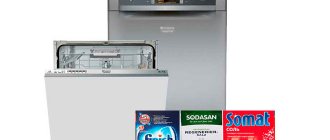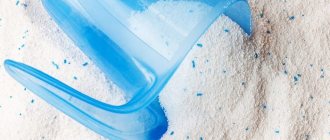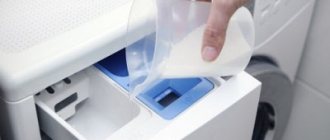All water flowing in pipes and from the tap contains calcium and magnesium. The higher the concentration of these salts in water, the harder it is considered. If such water is used to wash dishes in a dishwasher, then scale will begin to appear on individual elements of the device over time, which can subsequently lead to failure of the machine.
To prevent this, manufacturers of such devices equip dishwashers with ion exchangers. These devices contain a resin that attracts calcium and then eliminates it. However, to regenerate the resin, sodium chloride is needed, which is the main component in dishwasher salts.
Salt for dishwashers not only prolongs the life of the device, but also helps to better clean the dishes from dirt, since after washing there are no streaks or stains left on the mugs and plates.
What does salt contain?
Many people may think that dishwasher salt is almost the same as regular table salt, but this is not the case. First, dishwasher salt comes in larger granules. Secondly, such salt undergoes thorough purification, after which it simply cannot contain any impurities.
In addition, depending on the manufacturer, it can be made with the addition of the following components:
- Sodium citrate (serves to destroy germs and bacteria);
- Sodium percarbonate;
- Various flavoring agents;
- Sodium disilicate and bicarbonate;
- Sodium polyaspartate.
The above substances give the products of individual manufacturers distinctive properties. For example, some variations give water antibacterial properties or imbue it with a pleasant aroma.
How and when to fall asleep
It is recommended to add salt before turning on the Electrolux machine. Adding water will help the substance dissolve faster, which will help improve dishwashing. When using tablets, they should be placed in the detergent compartment, which is most often located on the inside of the door.
Salt is always loaded before turning on the machine - this is necessary to protect against corrosion.
How to choose dishwasher salt
Today, a large number of different salts for dishwashers are produced. Thanks to this, each owner of such a device can choose a product that will have the optimal cost and composition. Most often, dishwasher salt is sold in granules, packaged in cardboard boxes or plastic bags.
dishwasher salt
This product is produced by almost all leading manufacturers of dishwasher detergents, which are suitable for all popular brands of PMM (Electrolux, Bosch, Siemens, etc.).
The drug is produced by the following brands:
- Clean and Fresh;
- Gut and Gunting;
- Elly;
- Finish;
- Kraft et al.
Some brands produce dishwasher salt in large tablets.
salt tablets
The following brands produce such drugs:
- Dr.Prakti;
- Frau Schmidt;
- Lotta;
- Topper et al.
Some dishwasher owners want to save money and, instead of special dishwasher salt, pour regular table salt into the device. It is strictly forbidden to pour it in, since over time the ion exchanger will begin to become clogged with impurities contained in ordinary salt, which will lead to breakdown of the device.
The most popular and sought-after brands of salts
- Our domestic manufacturer of various detergents, Finish, has long established itself for the quality and effectiveness of the products it produces. Thousands of customers who use the products of this brand respond only positively about its products. Including, there is also a salt solution for dishwashers from this manufacturer on the market. The product is enough for 25-30 dishwashing processes. The product is affordable and effective in use. Among the advantages are preventing the formation of scale on mechanisms and elements of equipment and softening the hardness of tap water. Due to the fact that salt foams well, there are no streaks or stains left on the dishes. A one and a half kilogram pack costs approximately 200-230 rubles.
- One of the most affordable and accessible brands of salt is “Magic Power”. Despite the rather low cost, salt performs its functions properly. In addition to salt, the manufacturer produces tablet rinse aids for dishwashers, detergents and salt with a softening effect. For proper and effective use of salt, the manufacturer recommends reading the instructions on the package. A pack of this product costs about 140 rubles.
- Another effective and efficient remedy is “Topperr”. It is available in the form of tablets or large crystals. The composition is selected in such a way that this salt helps soften the water, making the dishes very clean and shiny. For a one and a half kilogram pack or for 167 tablets you will pay about 450 rubles.
Do not underestimate the importance of sodium chloride for dishwashers, because its effect is truly priceless. It is thanks to this product that your dishwasher will serve you faithfully for many years, because salt rids the parts and mechanisms of equipment from the harmful effects of scale and impurities found in dirty tap water. In addition, it is salt that helps clean dishes from corrosive dirt, providing them with a beautiful shine and whiteness.
Today on the market of chemical detergents, there is a huge selection of different brands and manufacturers of specialized salts for dishwashers, so you can choose anything according to your wallet and your taste. You should not save on this product, because future repairs may cost you much more. It’s not for nothing that they say that the miser pays twice. Taking good care of your dishwasher is not that difficult, but it will repay you in full in the future.
How does water hardness affect salt consumption?
As mentioned above, the harder the water, the more salt is needed to clean it. To independently determine the hardness of water, there are 3 ways:
- Approximately. In this case, you need to take a piece of ordinary laundry soap and soap a piece of fabric with it. If a piece of fabric practically does not lather, then the water has a high level of hardness.
- By observation. You can also observe the plumbing elements that are constantly in contact with water, for example, the faucet. If plaque quickly appears on it, then the water is hard.
- T eats stripes. This way to find out water hardness is the fastest and most accurate. You just need to dip the strip in water, after which you can tell the water hardness by the color of the strip. The color can vary from light blue to dark blue. The lighter it is, the less hard the water.
water hardness test strips
Products offered in the retail chain
Today, the choice of household chemicals intended for dishwashers is very wide. In this variety, salt is available in the form of loose granular and crystalline compositions, as well as in the form of tablets.
The most common type of sodium chloride for dishwashers is in the form of crystals or granules
Many companies produce these drugs. The most famous are “Finish”, “Calgonite”, “Topper”, “Somat”, “Start”, “Magic Power”. Users willingly buy products from brands such as Clean & Fresh, Paclan Brileo, Top House and other lesser-known manufacturers.
Manufacturers claim that salt in dishwasher tablets is consumed 1.5 times more than in crystalline formulations
Sodium chloride in the form of tablets is produced under the trademarks Topper, Frau Schmidt, Dr Prakti, Crystal-fix, Lotta, etc. As a rule, manufacturers indicate the dosage of the product on the packaging. It is not difficult to buy household chemicals for dishwashers - all the necessary components are widely represented in the retail chain.
How much salt to add
How much salt should I put in the dishwasher? Many people ask this question. Manufacturers advise filling the compartment to the top - it usually holds 0.8 - 1.2 kg of the drug.
How often do you put salt in the dishwasher? Dishwasher owners assure that one full filling of the dishwasher with salt is enough for about 1-2 months (including daily use).
You need to add a new portion of salt only when the corresponding indicator lights up on the dishwasher display, indicating that there is no salt in the ion exchanger.
salt indicator on the PMM panel
The rate of salt consumption is directly affected by the level of water hardness. The easiest way to find out this level is to contact the utility company, but you can also use the above methods.
Water hardness and product consumption - table
In order to choose the correct dosage of the product, determine the hardness of the water in your home. You can do this in several ways:
- Use special test strips that will help you determine the indicator with maximum accuracy.
- Carry out a small experiment - soak a cloth in the liquid and soap it with laundry soap. If you cannot wash it easily, the water is very hard.
- Pay attention to the plumbing. The appearance of plaque or scale on the tap and other surfaces indicates increased hardness.
Experts recommend checking this indicator once every few months, since it can change under the influence of various factors.
In order to accurately determine the amount of product, consider several important points:
- hardness of water;
- model and brand of the device;
- form of the substance.
The approximate salt consumption in the dishwasher is presented in the table:
| Rigidity | Amount of product (approximately) |
| High | 1 kg |
| Average | 0.75 kg (2/3 pack) |
| Low | 0.5 kg |
The indicated amount will last for several months, depending on how often the device is used. (Before putting the device into operation, check the special indicator.)
In modern models, salt is poured into the compartment until it is completely filled. At the same time, containers in different Electrolux, Bosch or Siemens models differ in size and capacity.
If not enough salt has been added, an unaesthetic and harmful white coating will remain on the dishes after washing.
Replenish sodium chloride if the indicator flashes at the 2-3 mark. Don't let the indicator drop to zero. If there is no indicator on the device, add salt when the colored mark is not visible on the water softener tank.
To ensure long service life of your dishwasher, make sure to use the correct cleaning and care products. The use of salt will prevent the formation of plaque and ensure normal operation of the device for a long time.
Where to sleep
Before you turn on your new dishwasher for the first time, you need to thoroughly read the instructions that come with the unit. There, the new owner of the dishwasher will be able to find technical specifications, as well as operating devices.
Under the lid: a container where you need to add salt for dishwashers.
The salt compartment in most dishwashers is located under the dish compartment.
For example, this arrangement can be found in models from Bosh, Electrolux or Siemens. Once the compartment is open, you will need to unscrew the plastic cover and then pour salt into the holes. At the end of the procedure, the lid is screwed back on.
For owners of Bosch dishwashers
Let us give examples from the instructions for the Bosch brand PMM, from which it is clear that it is necessary to use salt.
Hardness reducing device
In order for the washing to take place at the proper level, purified water, without calcium salts, must be supplied to the machine. Otherwise, scale will appear on the walls, dishes and parts of the machine. Water with high calcium hardness must undergo a purification procedure before reaching important parts of the device. To soften the water, a device built into the body of the machine is used; salt is poured into it.
Settings
It depends solely on the hardness of the water and not on any other indicators. To set up an ion exchanger, proceed as follows:
- Find out the hardness of your water supply.
- Use the hardness table provided to calculate the setting value.
- Turn the switch to 2.5.
In some models this is done as in the photo.
Using salt
When washing, the substance is automatically taken from the container and goes into a tank in which the softening process takes place. And the solution, which contains calcium salts, is drained into the sewer. Upon completion of the cleaning cycle, the system is again ready for further operation. Regeneration starts only when the salt is 100% dissolved.
Before starting the PMM, pour approximately 1 liter of water into the container for salt granules. For these purposes, use the funnel that comes with the device. Load the amount of granules that will raise the water level to the edge of the container (no more than 1.5 kg of substance). Since when loading the substance, water will pour over the edge, you need to load salt only just before turning on the device, otherwise such operation threatens rapid corrosion of the surfaces.
If during loading you spill the product a little, remove the spilled grains and close the container with a lid, making sure that there is no distortion.
By turning the ion exchanger regulator to o, you do not have to add salt, since water will bypass this device. With values ranging from “1” to “4” it is necessary to add salt.
Important! Do not pour powder into the special hopper or add gel or rinse aid - this will damage the device.
Tips for using salt
Some people make a number of mistakes when using dishwasher salt.
To avoid them, experts have identified a few simple tips that will help make dishes cleaner and also extend the life of the dishwasher:
- If your dishwasher has the ability to select water hardness, then you need to set the appropriate value. Some people do not pay attention to this function and set the value “to hell”, because they are simply too lazy to find out the hardness of the water they use. This leads to the appearance of scale on some parts of the dishwasher and impairs the cleaning of dishes;
- You only need to add salt when the corresponding indicator lights up. It is strongly not recommended to pour the product into the dishwasher;
- Do not pour regular detergent into the salt reservoir. This will lead to failure of the ion exchanger, the repair of which costs considerable money.
Do you need salt when washing with tablets?
If the region has low water hardness, it is possible to use combined tablets containing powder, rinse aid and regenerating crystals. In this case, the salt composition may not be added. But not everyone likes 3-in-1 products. When washing dishes with powder, salt is necessary.
Water of medium and high hardness cannot be used in PMM without special salt, regardless of the type of detergent.
For excellent cleaning results and proper functioning of the Bosch dishwasher, you need not only high-quality powder, but also a special salt composition. Timely replenishment of the reservoir with salt ensures uninterrupted operation of the equipment and frees the housewife from manual labor.
How to replace salt
Sometimes people, in order to save money, try to replace a specialized salt substance with a regular cooking mixture. However, not only will you not save money, but, on the contrary, you may even provide yourself with an additional expense item, since kitchen salt contains impurities that, when settled, can clog the internal mechanisms and parts of the dishwasher, which will subsequently lead to its breakdown. Compared to repair work, sodium chloride for dishwashers is not that expensive. Dishwasher detergent goes through several stages of cleaning, and its large particles are easy to use. Finely ground table salt does not have the properties that are so necessary when operating a dishwasher.
Select the desired program
You can wash dishes in the dishwasher using various programs. The instructions included with your assistant describe the entire range of features and functions; you should definitely read them.
- In most cases, good results are achieved when using a standard program (economy or eco). If the dishes are very dirty, then the intensive washing mode is used - it washes well, but consumes maximum energy and water, so it is better to run the PMM at night.
- The delicate mode is designed to wash particularly fragile dishes, such as glasses or crystal wine glasses. The delicate mode means the machine has a built-in heat exchanger that helps raise the water temperature during the first rinse.
- In the case when you collect completely different dishes in the dishwasher, it is also worth turning on the gentle mode.
- The machine will wash dishes for 1.5 hours or 1 hour in the standard program. The dishes will be hot after the cycle has completed, so wait another quarter of an hour before opening the door.
- To prevent drips, the lower compartment is emptied first, followed by the upper one.
- There are other rules. So, after each wash you should clean the filters. And to care for external surfaces, use damp sponges. You will also need to periodically clean the impeller nozzles to prevent them from clogging and clean the machine itself of scale if it has formed.
Support the project - share the material with your friends on social networks:
Loading dishes correctly
Now that we've sorted out the means, let's start loading. Poor washing is in 85% of cases a sign that the dishes were put in incorrectly, and not at all a signal of problems with the dishwasher.
How to load dishes correctly?
- We clean the dishes from food residues;
- We fold the dishes tightly and compactly, but so that they do not interfere with the rotation of the sprinkler arms, the opening of the dispenser, and the free passage and drainage of water. In many PMMs, sections can be rearranged to accommodate vases and baking trays;
- Pour in the powder or add a tablet; if necessary, add rinse aid and salt;
- Select the appropriate program and launch it. If you forgot to put something in, you can open the door and add the dishes, the machine will resume operation in a few seconds.
- Glasses and fragile glassware are placed at the top. It is important that it does not touch the walls. But the dishes with the most contamination are placed downwards, because this is where the strongest water jets are;
- The correct thing to do is to load the dishwasher completely, and only then turn it on;
- You can place a small batch of dishes after dinner in the tray and close the lid - this way the utensils will not dry out while waiting for the next batch. Better yet, select the half-load mode;
- The dirtiest surfaces should face down, so bowls, pans, etc. are turned upside down.
- And for small utensils such as knives and spoons, there are special trays that need to be used. It is better to alternate forks and spoons, and place the knife with the blades facing up. Only after you have correctly positioned the dishes can you turn on the machine.
Do not forget that the equipment washes dishes with hot water, so it is not allowed to place in it:
- Appliances with steel elements that may rust;
- Dishes with inserts of wood, mother-of-pearl, tin or copper elements;
- Cups with patterns or coatings that are not thermally durable;
- Glued items;
- Antique dishes;
- Plastic elements that do not have the appropriate approval markings;
- Sponges and kitchen towels;
- Crystal can be washed, but be careful, as it may become cloudy over time.
Rating of brands and manufacturers
Almost every manufacturer of dishwashers also produces salt and detergent compositions for them, or recommends directly in the instructions for the machine to use a salt version of a particular brand with a specific dosage.
Prices for sold salt formulations vary little by brand - if saving money is not a priority, then it is best to purchase branded preparations recommended by the manufacturer of the dishwashing equipment in the kitchen
It is difficult to create a comprehensive rating of dishwasher salts, taking into account many different parameters. A similar composition is almost pure sodium chloride (usually the mass fraction of NaCl in them is 99.5–99.7%!). Inventing something special here is problematic.
According to the standards, the product in question should not contain additives, rinsing aids, impurities or detergents. If anything similar is included in the description of the composition, then this is not an active salt for the ion exchanger, but a regular dishwashing detergent in an automatic dishwasher such as “3 in 1”, “5 in 1”, “ALL in 1”, etc. . Such tablets and powders are placed in a completely different compartment in the dishwasher.
The best option for regenerating salt is large NaCl crystals. The finely ground powdered analogue is used up too quickly; it is better to avoid it in the store. You need to look for a salt product in the form of granules with a minimum size of 4–6 mm. Tablets are also good in this regard, but not every ion exchanger can contain them simultaneously in the required quantity.
1st place – Finish Calgonit
First place was given to Finish Calgonit due to the almost complete absence of negative reviews from housewives for products under this brand. In terms of cost, this salt is in the middle price segment.
Finish Calgonit is distinguished by high quality NaCl purification and large granules, whose characteristics are more consistent with premium products
This manufacturer also has products designed for washing dishes. We talked more about the brand's products in this material.
2nd place – Sodasan
Sodasan is as good as Finish Calgonite in sodium chloride purity, but costs a little more.
We recommend: How to whiten white sneakers at home
Final third place - Somat is a classic middling player.
In addition to salt, this manufacturer's product range includes highly effective tablet dishwashing detergents.
4th place – Eonite
Under the Eonit brand, there are two types of anti-scale salts on the market: regenerating NATURAL and CLEANVON.
The first product is positioned as made from natural raw materials, and the second – with 99.9% purification! But the naturalness of NaCl is a big question.
If the dishwasher is used frequently and a lot of dishes are washed, then this is a great option. However, if you use the dishwasher infrequently, it is better to take a cheaper anti-scale product
In all cases, you will have to pay about 100–250 rubles for a 1.5 kg pack of salt. The price depends on the region, the seller and discount promotions.
If a cheaper product is offered under a different brand with a cost below 100 rubles, then you should take it with caution. Cheapness here is the first sign of too small granules or low purity of sodium chloride. As a result, you will pay less for salt, but it will quickly be used up or cause damage to the washing machine.
What kind of deposit forms on the dishwasher?
According to the photo, a white coating is visible on the bottom of the dishwasher and on the door.
To check, I drew the word “plaque” on the door of my dishwasher with my finger. Limescale deposits cannot be erased at the touch of a finger; they can only be scratched with your fingernails. From this I conclude that it is not limescale that has accumulated on the bottom and door of my dishwasher over the course of the year, but ordinary dirt, maybe it’s poorly washed off powder.
How do I deal with plaque? I use dishwasher cleaner. The last time I cleaned the dishwasher was a year ago with Finish cleaner. This cleaner is expensive. Therefore, I chose an analogue Lotta cleaner, its price is no more than 200 rubles. Right in the store, I compared the composition of Finish and Lotta, all the components were the same.
What is it for?
Tap water used for washing dishes contains impurities. These are substances that change the properties of a liquid under certain conditions, for example, due to heating. As a result, scale forms on some parts (heating element, tube walls).
The content of dissolved calcium and magnesium compounds leads to such consequences. When exposed to high temperatures, they settle on surfaces, where they gradually harden.
It is impossible to remove plaque in the usual way. It is necessary to use aggressive cleaning agents (acid-based), but even these do not always solve the problem. You will have to contact the service center. In the most severe cases, the elements of the mechanism are replaced.
If you use salt, your equipment will be maintained unnoticed. At the same time, it is poured inside the mechanism, for which a special compartment is provided.
Be sure to add dishwasher salt from time to time. But the peculiarities of using the substance are taken into account: its unrestricted use in violation of the rules is unacceptable.










